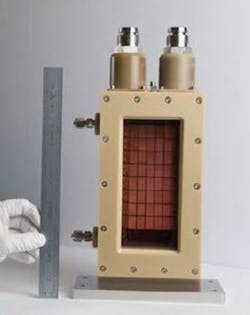LLNL installs record-setting laser diode arrays from Lasertel
Lawrence Livermore National Laboratory (LLNL) has installed high-powered laser diode arrays developed by Lasertel (Tucson, AZ) that will act as the primary pump source for the High repetition-rate Advanced Petawatt Laser System (HAPLS), which will be installed at the Extreme Light Infrastructure (ELI) facility in the Czech Republic.
Constantin Haefner, HAPLS program director at LLNL says the laser diode arrays are the highest peak power modules ever produced and, as the primary pump source for the HAPLS laser, will be the enabling technology for this next-generation, high-rep-rate Petawatt laser system.
The LLNL-designed HAPLS laser will be capable of reaching peak powers greater than one petawatt. When installed at the ELI, the Petawatt laser will drive international scientific research in areas as diverse as advanced imaging, particle acceleration, medical applications, biophysics, chemistry and quantum physics in addition to national security applications and industrial processes such as laser peening and laser fusion.
Related articles:
LLNL awards contracts for the petawatt laser system for the ELI Beamlines facility
Extreme Light Infrastructure: The ELI aims to break down the vacuum
Each semiconductor laser diode array consists of multiple 888-nm laser diode bars mounted on water-cooled stacks. The array operates at a brightness of 10 kW/cm2, a world record, at a repetition frequency of 10 Hz. Each array operates at a total peak power of 800 kW, with four such arrays combined and used as the primary pump sources for the HAPLS laser. Over 500,000 combined laser diode emitters, the largest number ever assembled, create the combined total diode optical input power of 3.2 MW.
Source: Lasertel

Conard Holton
Conard Holton has 25 years of science and technology editing and writing experience. He was formerly a staff member and consultant for government agencies such as the New York State Energy Research and Development Authority and the International Atomic Energy Agency, and engineering companies such as Bechtel. He joined Laser Focus World in 1997 as senior editor, becoming editor in chief of WDM Solutions, which he founded in 1999. In 2003 he joined Vision Systems Design as editor in chief, while continuing as contributing editor at Laser Focus World. Conard became editor in chief of Laser Focus World in August 2011, a role in which he served through August 2018. He then served as Editor at Large for Laser Focus World and Co-Chair of the Lasers & Photonics Marketplace Seminar from August 2018 through January 2022. He received his B.A. from the University of Pennsylvania, with additional studies at the Colorado School of Mines and Medill School of Journalism at Northwestern University.
